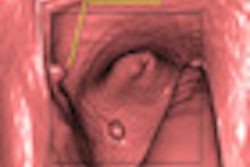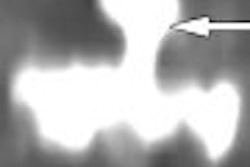Virtual colonoscopy is improving in important ways -- as it must to keep up with optical colonoscopy, according to a recent presentation at the European Congress of Radiology (ECR) in Vienna.
If it's true that most improvements in virtual colonoscopy have been incremental rather than groundbreaking, putting them together has improved VC substantially in recent years, said radiologist Dr. Patrick Rogalla from the Medical Faculty Charité and Humboldt University, Berlin, in a special VC focus session.
"Some developments within the last two to three years are important," he said. But considering that innovations in conventional colonoscopy "also impact the value of our exam," radiologists would be wise to stay up-to-date with endoscopy's improvements as well.
Large German study shows widespread screening results
Free screening colonoscopy has been available in Germany since 2003 "by invitation if a patient has (reached) a certain age -- so it's a perfect database," Rogalla said. More than 1.7 million asymptomatic individuals have been screened to date, and results from the first 303,000 colonoscopies were just reported last month, he said (Wissenschaftliche Reihe, Band 59, ISBN 3-7691-8060-7).
Preliminary data show an overall prevalence of polyps and adenomas of about 28.3%, with higher rates of findings in men and older patients. Men age 70-74 had the greatest prevalence of lesions at 37.7%. Adenomas were found in 18.1% of participants overall, including 23.6% of men and 14.3% of women, the authors reported. Colorectal carcinomas were reported in 0.6%: in 0.8% of men and 0.5% of the women -- most at an early and very treatable disease stage. But advanced dysplasia was discovered in 5.8% of patients overall, demonstrating the need for screening.
Gastroenterologists need to perform at least 200 colonoscopies before they are deemed qualified to participate in the program, Rogalla said, but the providers' experience has not translated into a high completion rate for the exam.
"If you look at the literature, complete colonoscopy means intubation of terminal ileum," Rogalla said. "By that criteria only 23% of the colonoscopies (in the study) are complete -- interesting data that might put CTC (CT colonography or VC) a little more in the forefront -- and it pretty much goes along with other data published."
And the low reported participation rates, 2.4% of women and 2.0% of men overall, show that virtual colonoscopy will definitely have a role to play in screening, he added.
"Reimbursement is slightly higher when you perform screening colonoscopy than if the patient is symptomatic -- having an interesting effect on practice," Rogalla said. "If you call up the doctor and say, 'I would like to have a screening colonoscopy,' you get an appointment right away. If you say, 'I'm symptomatic,' you have to wait three months."
Another important development in colonoscopy includes spraying dye on an area of interest in the mucosa to highlight potential lesions, he said. Zoom endoscopy is another new field that is producing exciting results.
"These new endoscopes are so good they're down to the level of cytology" -- or nearly so, he said. Another new development that's already in practice is narrow-band imaging. "Instead of plain white light, they use a filter (to isolate) only a certain part of light spectrum, and some lesions become more conspicuous," Rogalla said.
Virtual colonoscopy evolves
The most important advance in virtual colonoscopy is higher sensitivity for colorectal lesions from the use of thin-section multidetector-row (MDCT). "Of course MDCT is not new, but it's quite clear now that we see more polyps and have more information when we use thin slices."
Slice thickness may have had something to do with widely varying sensitivities in three of the largest VC studies completed to date, he said, though there were other important differences in technique. For example, Cotton et al used slice thicknesses from 2.5-mm, and reported sensitivities of 55% for lesions 1 cm and larger (Journal of the American Medical Association, April 14, 2004, Vol. 291:14, pp. 1713-1719).
Dr. C. Daniel Johnson and colleagues reported sensitivities of 56% to 79% for polyps 1 cm or larger using 5-mm thick slices (Clinical Gastroenterology and Hepatology, April 2004, Vol. 2:4, pp. 314-321). In 2003 Pickhardt and his team at the U.S. Department of Defense used thinner 2.5-mm slices, yielding sensitivity of 93% for lesions 1 cm and larger (New England Journal of Medicine, December 4, 2003, Vol. 349:23, pp. 2191-2200).
In 2003 Taylor et al imaged an explanted human colon. Reducing the slice thickness from 2.5 mm to 1.25 mm significantly improved the detection of 1-cm polyps (Radiology, October 2003, Vol. 229:1, pp. 109-118).
"Thin slicing is the way to go," Rogalla said, and "one should always use 1- or 1.5-mm slice thicknesses" to improve the detection of smaller polyps. "If you're willing to accept only detection of larger polyps, you can well go ahead with 5-mm slices," he added; interpretation might even be easier with fewer "tiny dots in the colon" to deal with.
For reducing radiation exposure, there's "no reason why you can't use dose modulation," Rogalla said, citing a study by Graser et al in Munich, Germany (American Journal of Roentgenology, September 2006, Vol. 187:3, pp. 695-701). "In fact you have two choices: you can either have changing noise levels in the entire (dataset, or) you can reduce or increase dose where it is needed and maintain even noise levels.
As for bowel prep, "it has been shown in a study that in patients who are poorly prepped, IV contrast material is beneficial" (Radiology, December 2000, Vol. 217:3, pp. 765-771), Rogalla said. "Poor prep means lots of stool and lots of fluid left in the colon, and in that situation IV contrast material might help" by creating a difference in attenuation between polyps and stool, he explained.
Prepless virtual colonoscopy is also making gains, and oral contrast taken with meals two days before imaging has been shown to be useful -- using barium contrast as well as iodine-based sodium amidotrizoate and meglumine amidotrizoate (Gastrografin, Bayer Schering Pharma, Berlin).
Of course, polyps can be difficult to visualize in an unprepped colon, and oral contrast agents taken over two days before imaging, both barium and iodine-based, have been used successfully, Rogalla said.
Using gastrografin alone in average-risk patients, Iannaccone and his colleagues from the University of Rome found an average sensitivity of 95.5% (95% CI, 92.1% to 99%) for the identification of colorectal polyps 8 mm and larger (Gastroenterology, November 2004, Vol. 127:5, pp. 1300-1311).
With the aid of barium alone, a study by Dr. Philippe Lefere et al found that "all relevant stool was tagged and only one polyp was missed in a series of 66 polyps in total," Rogalla said, and sensitivity was high for distinguishing stool from polyps (AJR, June 2005, Vol. 184:6, pp. 1836-1842).
"I must say that despite all the efforts, we still have problematic cases," he said of an example. "Tagging was being done, insufflation was being done, and still we see pieces of nontagged stool. So it's not a perfect technique."
Another important VC advance, automated bowel insufflation with CO² isn't new either, Rogalla said.
"What's brand new about insufflation is the fact that we now have nice publications which clearly show rectal insufflation with CO² gas and with automatic insufflation is beneficial," he said. Particularly on left side of colon you will get better distension and a lower number of collapsed bowel loops, maybe eliminating the need to turn the patient over, for the future" (AJR, June 2006, Vol. 186:6, pp. 1491-1496; AJR, January 2006, Vol. 186:1, pp. 96-103).
As for 2D versus 3D interpretation, "you could do a whole presentation" on which method is better, Rogalla said. But both are necessary in all cases, and most workstations now offer both methods -- "be it 2D with 3D for problem-solving or 3D with 2D for problem-solving."
New polyp visualization schemes go beyond simple 2D and 3D. Important players include virtual dissection, which comes with a "high degree of distortion, but it gives you a nice way of looking into folds and eliminating the need to go back and forth to look at folds that might be hidden," he said.
Another method, the unfolded cube display, offers "side views and antegrade and retrograde combined in a single view, and you are able to look between folds," Rogalla said. "Once they show up you have more time to see them. The problem is you don't see the surrounding tissue. That's why 2D correlation is always needed."
Computer-aided detection (CAD) is a hot topic for good reason, according to Rogalla. "When the computer can do the same thing I can, why should I sit at the computer?" he said. But system development isn't easy.
Four broad types of polyp detection schemes have been developed, including a few in clinical use, Rogalla said:
- Heat distribution systems designed to detect hot spots in the colon
- Edge-displacement systems that look for shape distortions in the mucosa
- Polyp-enhancement schemes that exaggerate the shape of the colon wall to facilitate polyp detection
- Systems built on shape indices that analyze shapes in the colonic mucosa and grade the likelihood of their being polyps
With shape indices, developed by Yoshida et al and incorporated into most systems currently in use, "the computer defines what the actual surface looks like," identifying shapes "that makes a polyp very likely to be present," Rogalla said.
Unfortunately, comparing different CAD systems on the same data yields highly heterogeneous results, with "completely different" polyp candidates detected by different systems, Rogalla said. "So CAD is not ready for prime time. It's a new thing and a lot more studies have to be done before it is ready for practice."
"I've shown you that innovation in colonoscopy improves sensitivity, and that new techniques, which even go down to macrosopic level, improve colonoscopy," Rogalla concluded. "The screening acceptance issue is still a problem, although we're much better now than we were in the past. There is a role for CTC."
In virtual colonoscopy, "thin slices are absolutely necessary," Rogalla said. "Insufflation with CO² improves insufflation.... Improvements in display techniques will eliminate the need to go back and forth and sideways, and speed up the review process. And for CAD there are multiple algorithms available, but I must say the results are quite heterogeneous."
By Eric Barnes
AuntMinnie.com staff writer
April 6, 2007
Related Reading
Narrow-band imaging enhances diagnosis of colorectal tumors, March 23, 2007
VC CAD ramps up detection of medium-sized polyps, March 12, 2007
VC CAD face-off reveals system differences. November 27, 2007
Prepless VC misses some diminutive flat lesions, January 17, 2006
VC visualization tool combines advanced features, August 17, 2006
Copyright © 2007 AuntMinnie.com



















